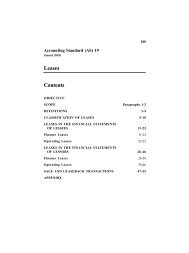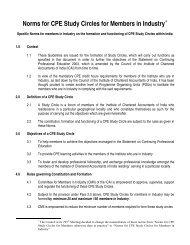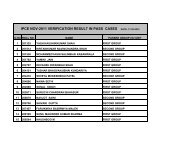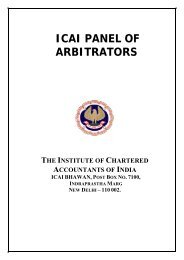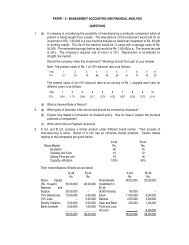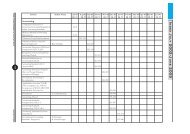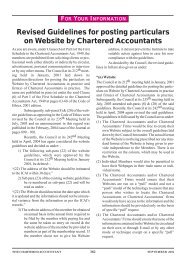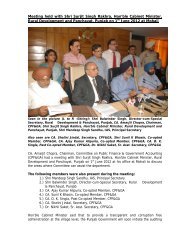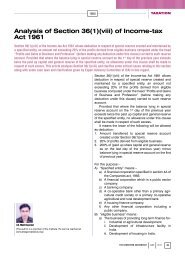The Chartered Accountant
The Chartered Accountant
The Chartered Accountant
You also want an ePaper? Increase the reach of your titles
YUMPU automatically turns print PDFs into web optimized ePapers that Google loves.
Now if we apply these probability concepts to our systems<br />
and plan to calculate these numbers, we see that<br />
our Indian Banking System did not have the infrastructure<br />
to load such intricate details and numbers in the<br />
past and neither did it have the data storage capacity<br />
and complicated sturdy systems to perform such operations<br />
today. So the entire scenario of calculations and<br />
detailed analysis goes for a toss. Not only this, Basel<br />
II emphasis on computation of probability of default,<br />
loss given default, migration mapping and supervisory<br />
validation require creation of historical database, which<br />
is a time consuming process and may require initial<br />
support from the RBI or large banks which is presently<br />
not there.<br />
Willingness for information Overload<br />
Pillar 3 of Basel II purports to enforce market discipline<br />
through stricter disclosure requirement. While admitting<br />
that such disclosure may be useful for supervisory<br />
authorities and rating agencies, the expertise and ability<br />
of the general public to comprehend and interpret disclosed<br />
information is open to question. Moreover, too<br />
much disclosure may cause information overload and<br />
may even damage financial position of bank.<br />
Consequences<br />
From the above analysis, three probable consequences<br />
emerge, the ripples of which are already being felt:<br />
• New standards are an amalgam of international<br />
best practices and call for introduction of<br />
advanced risk management system with enterprise<br />
level applications. Hence it has become a daunting<br />
task to craft the required level of technological<br />
architecture, and assemble human skill across an<br />
institution undertaking such appraisal and across<br />
the industry which is dragging to overhaul itself.<br />
Also the managerial cadre has to be properly<br />
trained for understanding of critical issues for risk<br />
profiling of supervised entities and validating and<br />
guiding development of complex IRB models.<br />
• <strong>The</strong> additional capital requirement posed by<br />
capital adequacy norms leads to large number of<br />
banks being forced to turn to capital market with<br />
IPOs7 and FPOs8 which is a noticeable market<br />
DECEMBER 2008 982 THE CHARTERED ACCOUNTANT<br />
AUDITING<br />
<strong>The</strong> working Group set up by the Basel Committee to look into implementation<br />
issues observed that supervisors may wish to involve third parties, such as<br />
external auditors, internal auditors and consultants to assist them in carrying<br />
out some or all of the duties under Basel II. <strong>The</strong> prerequisite is that there<br />
should be a rightfully developed national accounting and auditing principles<br />
and scaffold, which are in line with the best international practices.<br />
7 Initial Public Offer<br />
8 Follow on Public Offer<br />
trend today. This further has its own impact on<br />
the banking structure as it demands for dilution<br />
of Government ownership on these banks.<br />
Government has already been forced to increase<br />
the FDI limit by 74 per cent in banking sector to<br />
help these banks raise the required capital.<br />
• <strong>The</strong>se moves in the sector have grown pressure to<br />
consolidate domestic banks to make them capable<br />
of facing international competition. Given the<br />
significant dominance of foreign banks over the<br />
domestic counterparts, even after the consolidation<br />
of domestic banks the threat of takeover remains<br />
if the FDI limit is further relaxed.<br />
Status as on today<br />
An ASSOCHAM Eco Pulse study has brought out<br />
that most Indian banks have improved their capital<br />
adequacy ratio in line with the requirements of global<br />
Basel II norms, but suggests that they need to do more<br />
on international risk management practices in the wake<br />
of increasing pressure to bring down Non-Performing<br />
Assets (NPAs).<br />
Entitled 'Indian Banks and Basel Accord II', the study<br />
shows that the financial health of the Indian banking<br />
system has improved significantly. For instance, this improvement<br />
is vivid in terms of Capital Adequacy Ratio<br />
(CAR) during the third quarter of the fiscal 2007-08.<br />
In comparison to the mandated limit of CAR of 9%,<br />
the average capital adequacy ratio of commercial banks<br />
went up to 13 % in financial year 2008 from 12% in<br />
the previous year. Axis bank recorded the maximum<br />
increase of up to 16.88% in quarter 3, financial year<br />
2007-08 from 11.83% a year earlier in its CAR. ICICI<br />
Bank took the second position with an increase from<br />
13.37% to 15.82% in the current financial year. Other<br />
banks which registered a significant rise in CAR include<br />
ING Vysya Bank, whose ratio rose to 12.23%<br />
over and above 10.70% in the previous year, HDFC<br />
Bank from 12.80% to 13.80% and Centurion Bank of<br />
Punjab from 10.50% in the previous fiscal to 11.50%<br />
in the current fiscal. Punjab National Bank turned the<br />
corner by recording an increase in its CAR against a<br />
decline in the previous financial year. Its capital adequacy<br />
ratio dropped to 12.9% from 13.99% in quarter



